It’s official, the swashbuckling Eberron Campaign Setting has made its triumphant return to Dungeons & Dragons! First introduced in third edition D&D, this campaign setting takes cues from pulp adventure, pirate stories, and film noir. It also leans heavily into the many of the qualities that distinguish D&D from its other fantasy counterparts by creating a society powered by magic, elevating its medieval fantasy roots to levels of technology equivalent to Earth’s late 1800s and even early 1900s—with a Great War akin to our own War to End All Wars, to boot.
The Wayfinder’s Guide to Eberron was announced today on stream, and it is available on D&D Beyond and the Dungeon Master’s Guild right now! If you’re new to the realm of Eberron, let this primer be your introduction to a realm of airships, towering skyscraper castles, warforged automata, and morality as gray as a Seattle winter. Want to know more about the tone of Eberron? Todd Kenreck sat down with Eberron creator Keith Baker to discover the thematic building blocks of his legendary campaign setting.
Swashbuckling, Intrigue, and Noir
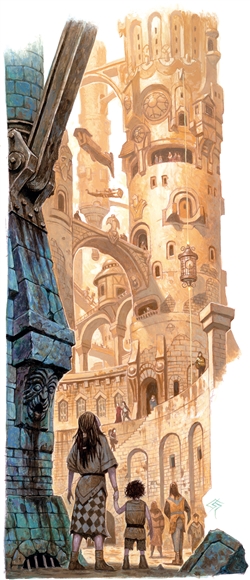 When the Eberron Campaign Setting was first published in 2004 for third edition D&D, it highlighted one trait of the setting above all others: its tone. Consider the many settings published throughout D&D’s history. The Forgotten Realms have a tone of epic, almost superheroic fantasy. Dark Sun is post-apocalyptic. Planescape has an air of whimsical-yet-edgy science fantasy. Eberron is pulpy, modern, and cinematic.
When the Eberron Campaign Setting was first published in 2004 for third edition D&D, it highlighted one trait of the setting above all others: its tone. Consider the many settings published throughout D&D’s history. The Forgotten Realms have a tone of epic, almost superheroic fantasy. Dark Sun is post-apocalyptic. Planescape has an air of whimsical-yet-edgy science fantasy. Eberron is pulpy, modern, and cinematic.
Some fans of the setting have described it as “dungeonpunk,” just like Blade Runner is cyberpunk or Katsuhiro Omoto’s Steamboy is steampunk. It is a society built on the principles of Dungeons and Dragon’s common-yet-miraculous magical powers… with all of the blessings and catastrophes that come with it. Games in Eberron can take place in the dark, rainy alleys of cities choked by skyscrapers, like in The Maltese Falcon. They may reach to far-off foreign lands and focus on the stories of war refugees from the Last War, such as in Casablanca.
If it wasn’t clear, Eberron draws heavily upon film and cinematic action. Whether it’s pulp like Raiders of the Lost Ark or The Mummy, swashbuckling drama like Pirates of the Caribbean: Curse of the Black Pearl, or film noir like The Big Sleep, morally dubious cinematic action is the heart of Eberron’s appeal.
New Lands, New Races
Stories that take place on the world of Eberron are focused primarily on the war-torn continent of Khorvaire, but the world extends to three other major landmasses: Xen’drik, a mysterious land of jungles and deserts home to the ruins of a long-forgotten civilization, Sarlona, a harsh land of unpredictable climate and extraplanar activity, and Argonnessen, an uncharted land ruled by mighty dragons.
Khorvaire is a continent of conflict. Stories set here are set against the backdrop of the Last War, a terrible conflict thematically similar to World War I—a war so horrific that it was thought no living being would ever dream to make war again. In this conflict, terrible machines were animated by magic for a single purpose: to destroy. These beings were the warforged, living constructs now freed of their warlike imperative, and they are the first of four new races introduced in Eberron. Warforged explore modern themes of soldiers returning from war, the oppression of the “other,” and even some existential questions usually reserved for science fiction.
The other races are changelings, the offspring of doppelgangers and humans, who possess minor shapechanging abilities. Changeling characters highlight film noir themes of deception and trickery in the modern age. Kalashtar are “planar entities merged with human hosts who are capable of becoming powerful wielders of psionic power.” They are native to the plane-scarred lands of Sarlona, and draw attention to the metaphysical mysteries of the Eberron setting. Finally, the shifters are beings sired by lycanthropes and humans. They possess the power to partially shift their bodies into bestial shapes and use the feral senses of an animal, conjuring images of wild pulp comics and novels of the early 20th century.
Todd Kenreck sat down with Mike Mearls to discuss the four races of Eberron and how they set Eberron apart from other settings.
Beyond these new races, Eberron recontextualizes all of the classic D&D races with new origins, backgrounds, and ways of life in order to fit with Eberron’s unconventional cosmology.
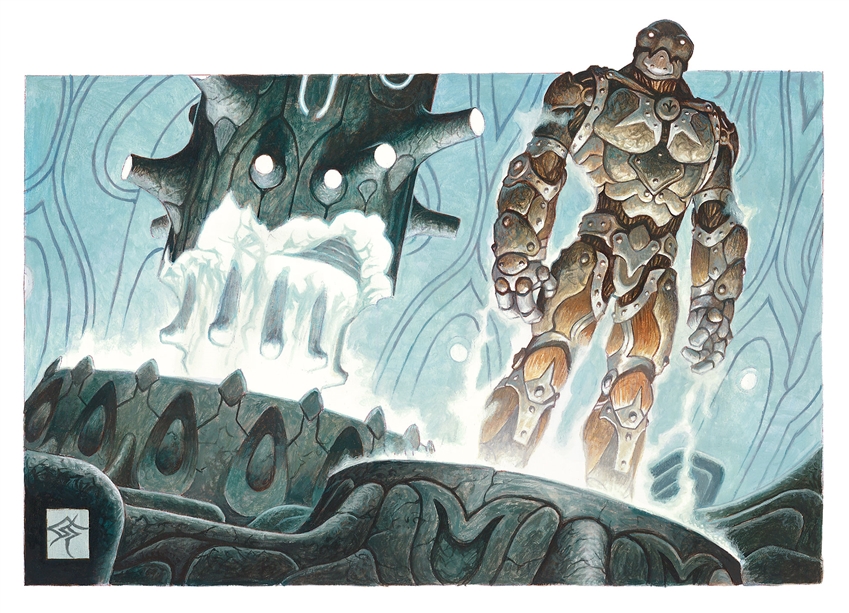
Disregard the Multiverse
For good or for ill, Eberron doesn’t fit neatly into the unified Multiverse presented in fifth edition Dungeons & Dragons. If I may editorialize, I love settings that disrupt the way the usual ordering of the planes and the gods, and give new origins for classic races like elves. Gods and planes don’t work like they do in the rest of D&D here; in fact, there is great debate within the lands of Khorvaire surrounding the very existence of the gods themselves. While all agree that so-called “divine” magic exists, no god has ever walked upon the face of Eberron and no creature has ever demonstrated that it can truly and directly communicate with them.
The gods of Eberron are entirely different from the gods of the Forgotten Realms, Greyhawk, or the archetypal Dawn War pantheon. In fact, most people do not worship a single god, but instead follow a religion and worship within the boundaries of a church, which may represent a single god or an entire pantheon. Some of these churches include The Silver Flame, a church devoted to truth, order, and justice, The Sovereign Host, the church of a pantheon that protects the lands of Khorvaire, and The Dark Six, whose sinister ranks are made up of foul deities banished from the pantheon of the Sovereign Host.
Beyond the power of the gods, the cosmos themselves are distinct from the view of the Multiverse presented in the Dungeon Master’s Guide and Mordenkainen’s Tome of Foes. The cosmology of Eberron has already changed once—between its original appearance in third edition D&D and the fourth edition Eberron Campaign Setting. There are four realms all but guaranteed to feature in the Wayfinder’s Guide to Eberron, but any other ancillary planes may shift about in the transition to fifth edition D&D.
The realms of the world were crafted from the bodies of the three Progenitor Dragons: Siberys, Eberron, and Khyber. The body of Eberron became the very planet upon which all adventures begin. Siberys’s body became the Ring of Siberys, a planetary ring that surrounds the body of Eberron. Siberys may also refer to the Astral Plane itself, the matter that conjoins all the planes in orbit around Eberron. The bones of Khyber became a subterranean realm akin to the Underdark of the Forgotten Realms, a vast network of cavers beneath both land and sea.
Distinct from the bones of the Progenitor Dragons is a final realm: Xoriat. It is a realm of madness that exists beyond the known universe, and is analogous to the Far Realm of the D&D Multiverse. It may even be another name for the selfsame Far Realm, as that region of terror and madness is also beyond the known Multiverse.
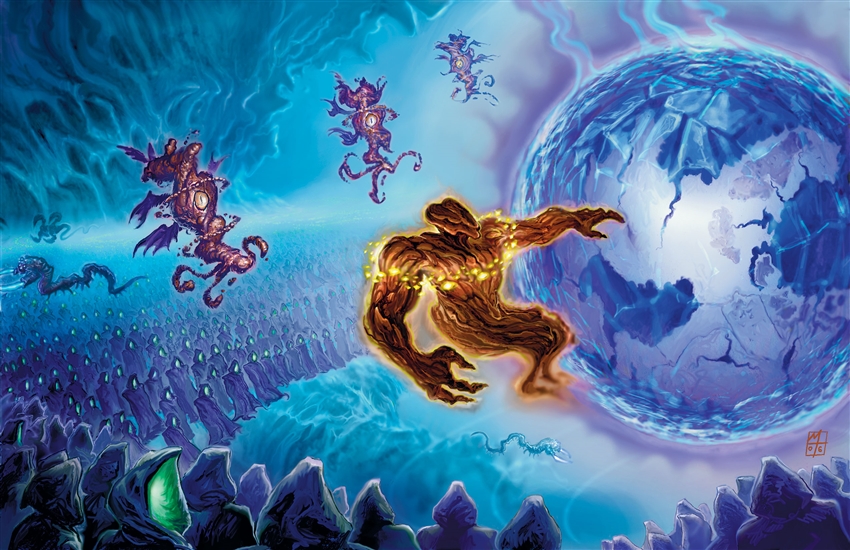
Power of the Dragonmarks
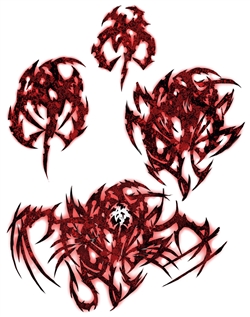 One of the more fantastical elements of Eberron are the dragonmarks. These strange symbols may manifest magically upon the skin of the members of the twelve great houses of Khorvaire, and grant their bearers rare and mighty powers. These marks appear on their bearers’ skin like birthmarks, but with the intricacy of an esoteric tattoo. Most dragonmarked individuals bear only a small mark, but a dragonmark can grow in power as its bearer improves their physical, mental, spiritual, and emotional selves—unlocking even greater power as it grows. The bearers of dragonmarks use their magic to secure not just magical but also social and economic power, making them a force to be reckoned with in Khorvaire's unstable political arena.
One of the more fantastical elements of Eberron are the dragonmarks. These strange symbols may manifest magically upon the skin of the members of the twelve great houses of Khorvaire, and grant their bearers rare and mighty powers. These marks appear on their bearers’ skin like birthmarks, but with the intricacy of an esoteric tattoo. Most dragonmarked individuals bear only a small mark, but a dragonmark can grow in power as its bearer improves their physical, mental, spiritual, and emotional selves—unlocking even greater power as it grows. The bearers of dragonmarks use their magic to secure not just magical but also social and economic power, making them a force to be reckoned with in Khorvaire's unstable political arena.
Dragonmarks are unpredictable and wild forces of magic, and do not always follow so simple a path of growth and improvement. They can jump in size and power suddenly and without explanation. An unusual and twisted mark, known as an aberrant dragonmark, has also been seen on people throughout the lands of Khorvaire. This unsettling icon only appears on those born of people with two different dragonmarked bloodlines, and it grants strange and unpredictable powers.
A World of Magical Technology
The streets of Sharn, the City of Spires, are shaded during the day by the height of the massive skyscrapers that crowd its skyline. The nations of Khorvaire are connected by the magical lightning rail, a train fueled not by coal but by elemental magic—and its tracks are not made of wood and iron but of magical conductor stones.
Magic items are crafted not by wizened sages of ages long past—okay, well some of them definitely were—but by modern magical inventors known as artificers. These innovators create items and infusions of magic that alter and define the world… but it was also the creators of magical items and weapons that led to the untold destruction of the Last War, and it will be their creations that fuel the flames of next war that follows. The nations of Khorvaire are already preparing for war, as over a century of brutal warfare has created rifts that no peace can heal.
As glorious as its magic is, the world of Eberron is in peril, and a single party of adventurers may not be enough to avert catastrophe. The future is always in motion in Eberron, and in a realm where red dragons can be good and clerics of lawful good gods can be rotten to the core, your heroes will find that anything is possible.
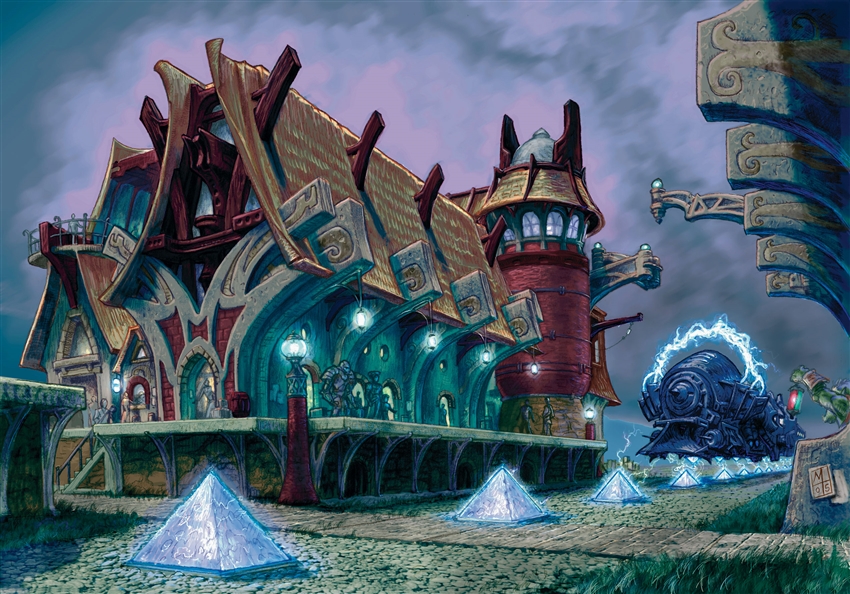
This article’s primary source was the Eberron Campaign Setting (2004) by Keith Baker and the Dungeons & Dragons team.
 James Haeck is the lead writer for D&D Beyond, the co-author of Waterdeep: Dragon Heist and the Critical Role Tal'Dorei Campaign Setting, and is also a freelance writer for Wizards of the Coast, the D&D Adventurers League, and Kobold Press. He lives in Seattle, Washington with his partner Hannah and his two shifters, Mei and Marzipan. You can usually find him wasting time on Twitter at @jamesjhaeck.
James Haeck is the lead writer for D&D Beyond, the co-author of Waterdeep: Dragon Heist and the Critical Role Tal'Dorei Campaign Setting, and is also a freelance writer for Wizards of the Coast, the D&D Adventurers League, and Kobold Press. He lives in Seattle, Washington with his partner Hannah and his two shifters, Mei and Marzipan. You can usually find him wasting time on Twitter at @jamesjhaeck.








-
View User Profile
-
Send Message
Posted Jul 23, 2018In addition to a Ravnica book too? ( Recent Amazon leak)
-
View User Profile
-
Send Message
Posted Jul 23, 2018WOO! So excited! Have they announced if there's going to be physical copies as well?
-
View User Profile
-
Send Message
Posted Jul 23, 2018Can't wait for everyone to play warforged...including myself.
Although, the Kalashtar seem like they'd be tons of fun to make with their stand- I mean planar entity.
-
View User Profile
-
Send Message
Posted Jul 23, 2018There will be a Print on Demand option made available through the DMs Guild in the near future.
-
View User Profile
-
Send Message
Posted Jul 23, 2018Awesome! Thank you!
-
View User Profile
-
Send Message
Posted Jul 23, 2018Wow . . . this looks amazing.
-
View User Profile
-
Send Message
Posted Jul 23, 2018So we are paying for UA and playtest material now?
-
View User Profile
-
Send Message
Posted Jul 23, 2018That is literally the point of UA and Playtest. To get feedback on their ideas and give them a full release in a new book. Though the versions we will see in Ebberon are likley very different from the UA.
-
View User Profile
-
Send Message
Posted Jul 23, 2018This is just making me want to right a campaign set in the world of Eberron. To bad I don't have money right now...
-
View User Profile
-
Send Message
Posted Jul 23, 2018No, Keith Baker wrote a 176 page 5e Eberron Campaign Setting Guide. It's not playtest material, it's an official release, just digital only (with it sounds like a POD option soon).
-
View User Profile
-
Send Message
Posted Jul 23, 2018But it’s not official is it? Content is still considered playtest material?
-
View User Profile
-
Send Message
Posted Jul 23, 2018"The first step is the Wayfinder’s Guide to Eberron, a digital release in the Dungeon Masters Guild online marketplace, which will serve to collect feedback on adjusted races, dragon marks, new backgrounds and more."
This is just test material
-
View User Profile
-
Send Message
Posted Jul 23, 2018Read the introduction, let me help : “ Bear in mind: this book presents my vision of Eberron. This is the world I run at my own table, and the way that I’ve converted its ideas to the fifth edition rules. All of the material here is presented for playtesting and to spark your imagination. The game mechanics are in draft form, usable in your campaign but not refined by final game design and editing. They aren’t officially part of the game and aren’t permitted in D&D Adventurers League events. If Wizards of the Coast decides to make this material official, it will be refined based on your feedback and then appear in a D&D book. Beyond that: Eberron is your world as much as it is mine. I hope that this book provides you with inspiration, but don’t be limited by my ideas or decisions. Think of this as something you can build upon, not a codex of absolute law.“
and the UA article for today is the same races from the race section.
-
View User Profile
-
Send Message
Posted Jul 23, 2018Well then at least the races shouldn't be included in the official list of races without the UA tag
-
View User Profile
-
Send Message
Posted Jul 23, 2018I am not very happy with this. I was under the impression when I bought it that it would be official game material, as playtesting has never been sold on this website, but unfortunately, I was mistaken.
Hopefully, my ownership of this will at least give me a discount or the full release.
-
View User Profile
-
Send Message
Posted Jul 23, 2018They've said that as the material is adjusted through playtesting, the updates will be pushed to those who have already purchased the book. (That's what they said about the DM's Guild PDF, anyway, I have to assume DDB is the same.)
-
View User Profile
-
Send Message
Posted Jul 24, 2018I'm glad that 5E is beginning to expand their boundaries from forgotten realms to the many other beloved settings. For so long there has been next to no support for settings such as Ravenloft, Greyhawk and Eberron, but with MToF and now this it has been made clear that WotC is pushing to include more settings.
-
View User Profile
-
Send Message
Posted Jul 24, 2018My question is, how are they going to handle the pricing when it moves from UA to an official book... Are we going to get a discount on the price of the official book by 19.99? or maybe we will get the updated items for free if the pricing match
-
View User Profile
-
Send Message
Posted Jul 24, 2018Any new classes? ((pls artificer, pls artificer, pls artificer))